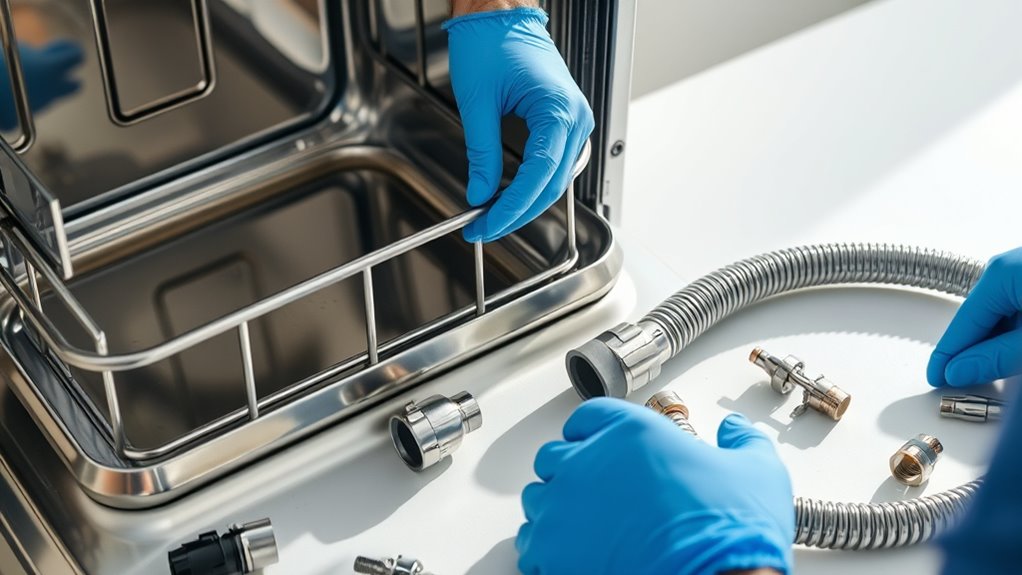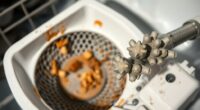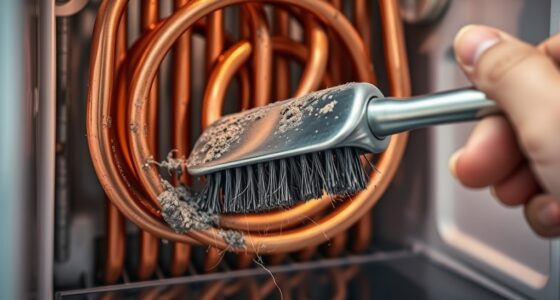To fix a leaking dishwasher, start by inspecting the door gasket for cracks or tears and replace it if needed. Check all hoses for cracks, leaks, or blockages, tightening connections or replacing damaged hoses as necessary. Confirm spray arms spin freely and are free of clogs by cleaning nozzles. Proper maintenance of these parts can stop leaks and improve performance; explore each step in detail to resolve your issue effectively.
Key Takeaways
- Inspect door gaskets for cracks or tears; clean and replace if leaks are detected.
- Check hoses for kinks, cracks, or damage; tighten connections and replace damaged hoses.
- Clear hose blockages with a pipe snake, flush with water, and ensure proper routing.
- Remove and clean spray arms, ensuring no nozzle clogs and smooth rotation for even water flow.
- Regularly inspect all components, maintain secure fittings, and address issues promptly to prevent leaks.
Inspecting and Replacing Gaskets
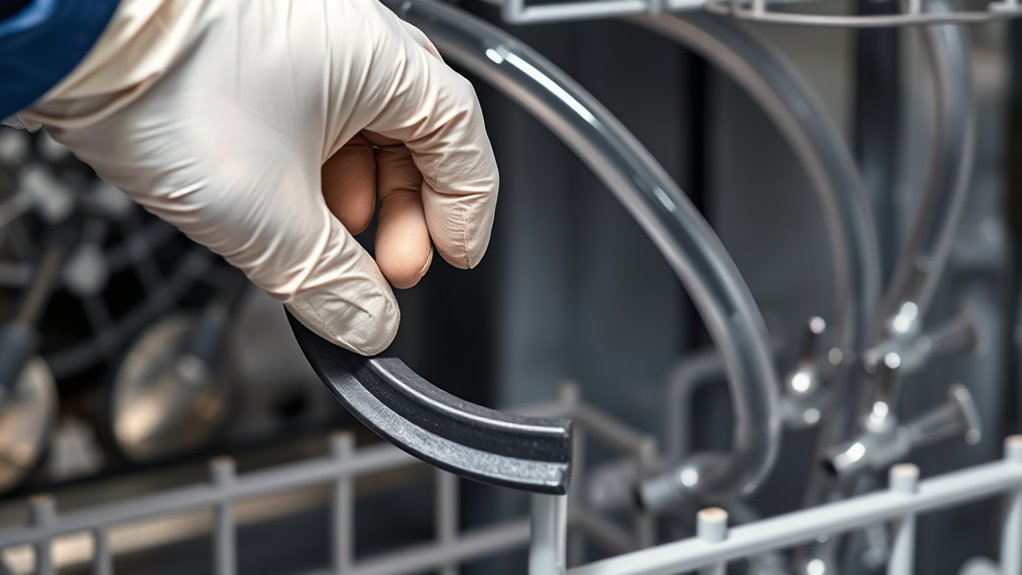
To prevent leaks and maintain your dishwasher’s performance, inspecting and replacing the door gasket is essential. First, remove the racks to access the gasket easily. Carefully examine the gasket edge for cracks, tears, or deformations, and gently pull it outward to check its elasticity. Clean the gasket channel with mild detergent and warm water to remove debris and mold. Make certain the gasket fits snugly all around the door without gaps or looseness. If you notice signs of wear—cracks, brittleness, or leaks—it’s time for a replacement. Remove the old gasket carefully, clean the channel thoroughly, and press the new gasket firmly into place, starting at a central point. Proper installation ensures a watertight seal, preventing leaks and protecting your flooring. Additionally, understanding the importance of emotional support can help address any frustration or stress that may arise during the repair process.
Troubleshooting and Repairing Hoses
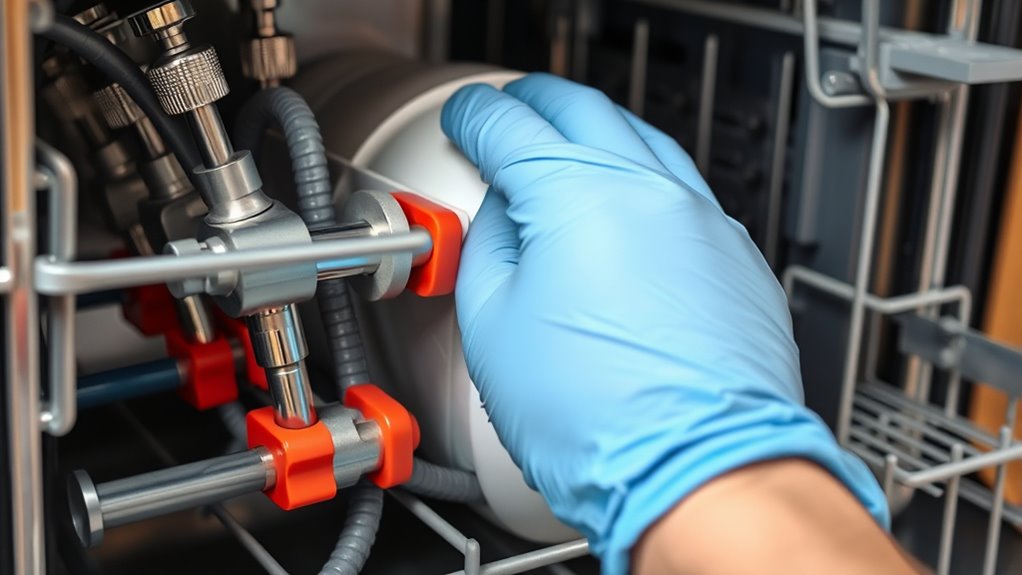
Inspecting and repairing dishwasher hoses is a key step in preventing leaks and ensuring proper drainage. First, disconnect the power for safety. Check hoses for kinks, cracks, or other damage that could cause leaks or blockages. Look inside the ends for debris or buildup. Ensure connections at both the dishwasher and sink or disposal are tight and secure. Examine hose sections for pinching or improper routing, which can restrict flow. To clear blockages, disconnect the hose and use a pipe snake or brush to remove debris, then flush with warm water. For persistent clogs, soak in vinegar or detergent before flushing. Inspect for leaks by checking for cracks or worn spots, and replace damaged hoses. Proper routing and secure fittings prevent future issues and leaks. Additionally, regularly inspecting the hoses helps identify potential problems early, preventing costly repairs. Regular maintenance of hose connections and careful routing can significantly reduce the risk of leaks over time.
Ensuring Proper Spray Arm Functionality

Ensuring your dishwasher’s spray arms function properly is essential for achieving spotless dishes. Regularly inspecting and cleaning them keeps water flowing freely and prevents clogs. Remove the spray arms by unclipping or unscrewing them, then soak in hot, soapy water. Use a pin or fine tool to clear blocked nozzles and verify smooth rotation. Proper installation ensures even water distribution. Incorporating automation technologies can also help monitor and maintain optimal dishwasher performance over time.
Frequently Asked Questions
How Often Should I Replace Dishwasher Gaskets?
You should replace dishwasher gaskets when you notice tears, cuts, or a loss of seal. For residential units, check them annually or biannually; commercial dishwashers may need monthly inspections. Timely replacement prevents leaks, water damage, and increased costs. Regularly inspecting and replacing gaskets guarantees your dishwasher performs efficiently, maintains sanitation, and extends its lifespan. Don’t wait for leaks—replace gaskets as soon as signs appear to keep everything running smoothly.
Can Clogged Spray Arms Cause Leaks?
Yes, clogged spray arms can cause leaks. When debris blocks the holes, water pressure increases, which can crack or split the spray arms or force water past seals. This excess pressure may also loosen hose connections or damage seals, leading to leaks. To prevent this, regularly inspect and clean your spray arms, ensuring they rotate freely and are free of debris. Proper maintenance helps avoid costly repairs and keeps your dishwasher functioning efficiently.
What Tools Are Needed to Repair Dishwasher Hoses?
Think of repairing your dishwasher hoses as untangling a stubborn knot. You’ll need pliers to loosen clamps, a nut driver to remove fittings, and screwdrivers for attachments. An adjustable wrench grips nuts tight, while a pipe cutter slices through damaged hoses. For smooth work, have a drill, measuring tape, and Teflon tape handy. These tools help you tame the hoses, sealing leaks and restoring your dishwasher’s harmony.
How Do I Know if My Spray Arms Are Working Properly?
You can tell if your spray arms are working properly by observing their rotation during a wash cycle. Confirm they spin freely without resistance or unusual noises. Check if water sprays evenly in a circular pattern, reaching all dishes. After the cycle, dishes should be clean and free of food particles. If there’s pooling of water or dishes remain dirty, your spray arms might be blocked or malfunctioning.
Are Leak Repairs Safe for DIY Homeowners?
Leak repairs can be safe for DIY homeowners if you stick to simple tasks like replacing door gaskets, cleaning spray arms, or tightening hoses, always following safety guidelines. However, avoid working on electrical components or internal plumbing that requires complex tools or knowledge. Always disconnect power and water first, use proper tools, and consult a professional if you’re unsure. Prioritizing safety keeps you protected and guarantees the repair works correctly.
Conclusion
With a keen eye and quick fixes, you can turn your dishwasher into a silent, leak-free workhorse. Imagine the steady flow of water, no drips or puddles, just the hum of a well-functioning machine. By inspecting gaskets, replacing hoses, and ensuring spray arms spin freely, you’re restoring order to your kitchen chaos. Soon, your dishwasher will run smoothly, like a well-oiled engine, leaving you with clean dishes and a dry, peaceful space.
